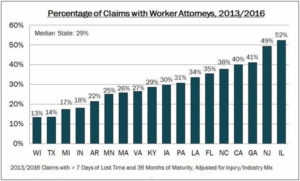We received a number of reader comments to our psychosocial claim issues series of last week. Our series highlighted the difficulty in dealing with these sometimes intractable claims where recovery is delayed and costs exacerbated. In Part One, we listed the litany of challenges facing claim managers; in Part Two we described how we had built Workers Compensation Psychological Network in New Jersey to overcome those challenges.
A few readers pointed out that we paid scant attention to the “social” in psychosocial. These adjusters and nurses wrote that too often they’d seen and handled claims where life and “societal issues,” the social, seemed to get in the way of recovery.
Sue Separa, who has overseen workers’ compensation claims for more than 30 years in 40 states and jurisdictions, put it this way:
Employee loses car, loses license, loses driving privileges and can’t get to work, but still needs a source of income;
Employee is having daycare issues and needs to be home, but also needs a source of income;
Employee has a sick relative or child they need to stay with/watch, but still needs a source of income;
Employee is attending school to better themselves, has a heavy school schedule, but still needs a source of income;
Employee has a comorbid or health situation that requires medical care and possibly surgery or absence from work, and has not secured short term disability, or it is not available with the employer;
Employee has asked for vacation time and it is denied due to no time left, or not eligible, or because someone else is off work at the same time.
And she’s right. Of course these real life situations occur. However, they’re present and happen all the time without injuries, too. They are non-physical, “social” comorbidities; things that can easily impede and delay return to work. Unless, that is, claim adjusters are trained and experienced enough, as Ms. Separa is, to dig a little deeper, find them and address them appropriately.
We also heard from our friend Robert Aurbach who wrote from Down Under to say, while he “applauds” our efforts and thinks “they are valuable,” he suggests “perhaps they don’t go far enough.” Rob believes the “problem is partly the system itself;” we create the harm our series cited. As that great American philosopher, Pogo, opined on Earth Day, 1971, “We have met the enemy and he is us.” The system is iatrogenic (system caused).
Rob Aurbach also sent a paper he authored in late 2015 for the Injury Schemes Seminar, put on bi-annually by the Australian Actuaries Institute. In the Paper (opens in pdf), titled “Better Recovery Through Neuroscience: Addressing Legislative and Regulatory Design, Injury Management and Resilience,” (bit of a mouthful that, but it won the Taylor Fry Award for the Seminar’s best paper) Rob explores Neuroplasticity, a theory dating from the 1800s and recently confirmed by functional Magnetic Resonance Imaging. Neuroplasticity is the process by which our brains continually rewire themselves throughout life due to environment, behavior, thinking and emotions. In short, it’s true; our brains are malleable. Rob writes that when work is disrupted through injury (or, through anything, really) for a long enough period, Neuroplasticity begins rewiring the brain to adapt to the new situation – being out of work. In other words, our brain creates a new “facilitated neural network.” This can happen in as little as 12 weeks, as Rob points out:
Timing is everything. There is a substantial research literature demonstrating that if a worker does not return to work within 12 -16 weeks, the probability of eventual return is reduced to 50% or less.
Rob Aurbach’s paper is a valuable contribution to understanding how easily a claim can deteriorate to the point where an injured person’s life is forever changed, and not for the better. We urge you to read it. It’s well-researched, well-written and profoundly thoughtful. It comes in at twenty-seven pages, the last seven of which are endnotes and references. We found the first half of the text compelling and enlightening. His common sense recommendations that follow are pretty simple, but wickedly difficult to implement: Claim managers and adjusters should intervene early, demonstrate respect for the injured worker, promote early return to work, align incentives that encourage recovery, restrain negativity, listen attentively to the worker’s story, etc. In short, all the things managers, nurses and adjusters like Sue Separa know they should be doing, anyway. Trouble is, for these often overworked professionals, each managing a steamer trunkful of claims, there isn’t a lot of time to devote to Rob’s prescription. The iatrogenic system isn’t built to allow it.
And that’s where behavioral health clinicians and therapists, for the most part underused and undertrained, ought to be helping far more than they are now. Part Two of last week’s series catalogued how, recognizing the difficulties, we built Workers Compensation Psychological Network and trained our clinicians to help anyone confronted with these demanding and formidable claims get to the right outcome sooner, faster and smarter. Injured workers, as well as the professionals charged with helping them, deserve no less.
